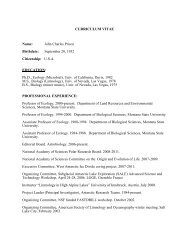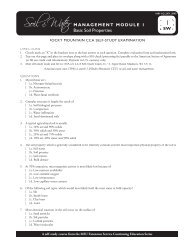Nutrient Uptake Timing by Crops - Department of Land Resources ...
Nutrient Uptake Timing by Crops - Department of Land Resources ...
Nutrient Uptake Timing by Crops - Department of Land Resources ...
Create successful ePaper yourself
Turn your PDF publications into a flip-book with our unique Google optimized e-Paper software.
CORN AND SUGAR BEET Since corn and<br />
sugar beet are usually irrigated and can be fertigated<br />
(adding nutrients in irrigation water), N fertilization can<br />
be timed to match their N needs. In a Manitoba study,<br />
maximum N uptake rates in corn occurred between the<br />
8-leaf to tassel emerging stage and again from silking to<br />
the dent stage (Figure 5). By the 10-leaf stage, 40 percent<br />
<strong>of</strong> the plant’s N had been accumulated. At maturity, 73<br />
percent <strong>of</strong> the total plant N was located in the grain (10).<br />
Over half the N required for grain fill came from the<br />
leaves and stalk. Therefore, insufficient N early in corn<br />
growth could greatly limit grain yield.<br />
In sugar beet production, the N demand <strong>of</strong> seedlings is<br />
relatively small but critical for the plants to attain canopy<br />
closure as quickly as possible (13). As these early leaves<br />
mature there is very high demand for N, because they<br />
supply much <strong>of</strong> the N needed for root growth (Figure<br />
5; 11). However, applying N after canopy closure or<br />
the onset <strong>of</strong> bolting causes increased top growth at the<br />
expense <strong>of</strong> sucrose quality and accumulation in the<br />
roots (12). After mid to late summer there should be<br />
no additional N uptake and the leaves begin to die as<br />
nutrients move into the growing roots.<br />
LEGUMES Legumes fix their own N if the proper<br />
inoculants and sufficient amounts <strong>of</strong> P, K, sulfur (S) and<br />
micronutrients are present (Growing Dry Pea in Montana,<br />
MT200502AG). Maximum N uptake occurs during<br />
branching and early bud formation (14). Therefore early<br />
growing season availability <strong>of</strong> P and K is critical not only<br />
for direct incorporation into plant biomass but to ensure<br />
early N fixation.<br />
CLIMATE Regional or yearly climatic differences will<br />
alter the rate and duration <strong>of</strong> nutrient uptake. The longer<br />
period <strong>of</strong> N, P, and K uptake <strong>by</strong> wheat in the Montana<br />
than the Saskatchewan study is likely because irrigation<br />
and rainfall (20 inches total during the study) allowed for<br />
continued water and nutrient uptake into maturity. The<br />
Saskatchewan study was on a dryland site (6 inches May<br />
to August rainfall in 1998 and 9 inches in 1999) where<br />
water and nutrient uptake would have been dramatically<br />
limited as plants approached maturity.<br />
Cumulative <strong>Nutrient</strong> <strong>Uptake</strong> (percent <strong>of</strong> maximum)<br />
Cumulative N <strong>Uptake</strong><br />
(percent <strong>of</strong> maximum)<br />
100<br />
80<br />
60<br />
40<br />
20<br />
0<br />
100<br />
80<br />
60<br />
40<br />
20<br />
0<br />
Early Leaf Tillering Stem<br />
Elongation<br />
Heading Ripening<br />
Plant Growth Stage<br />
FIGURE 3. Cumulative nutrient uptake as a percent <strong>of</strong><br />
maximum accumulation <strong>by</strong> dryland spring wheat over time in<br />
Saskatchewan; a) N in 1998 and 1999, b) P and K in 1998.<br />
<strong>Uptake</strong> curves are adapted from the original (5). Plant growth<br />
stages are approximate and adapted from the originals (6 and 7).<br />
100<br />
80<br />
60<br />
40<br />
20<br />
0<br />
Dryland Spring Wheat<br />
a. NITROGEN<br />
b. POTASSIUM and<br />
PHOSPHORUS<br />
Canola<br />
1999<br />
Seedling Branching Bud Flowering Ripening<br />
Formation<br />
Plant Growth Stage<br />
FIGURE 4. Cumulative N uptake as a percent <strong>of</strong> maximum<br />
accumulation over the growing season <strong>by</strong> canola grown in<br />
Saskatchewan in 1998 and 1999. Plant growth stages are<br />
approximate and adapted from the original (9).<br />
K<br />
P<br />
4<br />
1998<br />
1998<br />
1999







